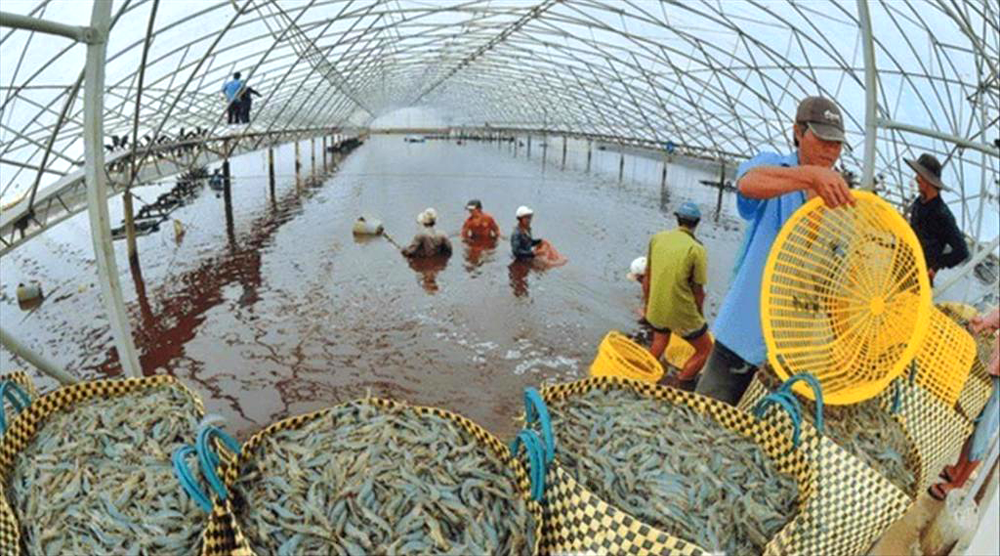Vietnam Seafood
Developing shrimp farming under forest canopy in Ca Mau
The particular ecological conditions along with large intertidal zone of coastal mangrove forest in Ca Mau province has created ideal conditions for developing shrimp farming under the forest canopy.
In the past time, the intercropping of shrimp in Ca Mau mangrove forests has been a good way to ensure the harmonious benefits between economic development and forest protection. This is also the most effective solution to help restore, protect and develop forests for coastal provinces.
Developing linkages between shrimp and forest value chains
According to Department of Agriculture and Rural Development Ca Mau, the production value of the Ca Mau shrimp currently accounts for 80% of the total production value of the aquaculture sector and 49% of the total production value of the whole agriculture industry.
For many years, seafood processing and export enterprises have coordinated with forest protection management boards, localities, units and farmers implementing many projects to develop linkages between the shrimp and forest value chain in the coastal province of Ca Mau. Currently, the total shrimp – forest farming area reaches more than 80,000 hectares; in which, international certification organizations have certified for more than 19,000 hectares of shrimp – forest according to international standards (Naturland, EU Organic, Canada Organic, Selva Shrimp, ASC, BAP, …), products are widely favoured and highly evaluated by many markets.
Director of Department of Agriculture and Rural Development Ca Mau – Mr. Phan Hoang Vu said that for certified shrimp and forest areas, businesses participating in the association will support payment for forest environmental services from 250,000 to 500,000 hectares/year and support for high quality seed for stocking purpose. Besides the main product such as black tiger shrimp, shrimp-forest farming households also have additional income from crabs, fish, blood cockles… This is an ecological and natural farming model that does not use drugs and chemicals, and does not incur production costs. Thus, excluding family labor and production costs, the profit is quite high, the maximum profit per year is 80 million VND/hectar.

Mr. Tang Kim Ngan in Tam Hiep hamlet, Rach Goc town, Ngoc Hien district shared that when engaging in the production of forest- shrimp chains, companies sign contracts to consume products and benefit from forest environment service fees. Shrimp products are sold at 5-10% higher prices than other types of farmed shrimp, and the production model environment is also very sustainable.
Ngoc Hien district, with three sides bordering the sea, has a large area of mangrove forest, currently building three key communes for forest – shrimp farming, namely Vien An Dong, Vien An and Dat Mui. In particular, in Vien An Dong commune, the first 500 households raising wild shrimp met the green standards of Seafood Wach (USA).
In addition, there are three seafood processing enterprises participating in the development of forest shrimp farming, including Minh Phu Mangroves shrimp social enterprise; Camau Frozen Seafood Processing Import Export Corporation (CAMIMEX group) and Nam Can Seaproducts Import Export Joint Stock Company. Seafood processing enterprises built two wild shrimp purchasing stations in Vien An Dong and Tam Giang Tay communes, creating favorable conditions for people to raise wild shrimp.
Mr. Nguyen Thanh Cao, in Tac Bien hamlet, Vien An Dong commune, shared: “Households that raise wild shrimp according to international certified clean shrimp standards will be purchased by companies with higher prices than other farming models from 5,000 – 10,000 VND/kg, helping farmers stabilize production and reduce the risk of shrimp prices.

Improve the effectiveness of forest protection and climate change adaptation
According Mr. Phan Hoang Vu, wild shrimp is a farming method associated with forest protection and mangrove planting, paying attention to the growth of green carbon sources in line with the trend of green development. In the world, shrimp farming under the forest canopy accounts for 30-40% of the water surface area and must ensure at least 50-60% of the forest coverage. This contributes in raising forest coverage, impulsing the ability to keep soil against landslides, and increasing resilience against climate change.
In addition, shrimp farmers are also paid for forest services and benefit from forest exploitation, thereby encouraging communities to participate in forest protection. The Directorate of Fisheries has also proposed to expand the implementation of this form of farming to contribute to achieving the national green growth target.
Faced with the challenge of climate change, Ca Mau province promptly recommends forest-shrimp farmers to proactively prevent, follow the seasonal schedule, choose the subjects and farming methods that are well adapted to high salinity environment to reduce damage, improve production efficiency. Simultaneously, strengthening disease prevention and control in farmed shrimp is key, disease prevention is associated with farming management, through good and disease-free seed management to limit the spread and arising of diseases.
As Mr. Phan Hoang Vu said, Ca Mau has also increased technology transfer and application, promoting the replication of the effective shrimp-forest farming model in the context of climate change. Encourage the application of new, efficient and environmentally friendly farming techniques such as Biofloc, farming models with little water change, 2- 3 stage farming, organic, energy-saving aquaculture, etc. Thereby, calling and encouraging businesses, especially seafood processing and exporting enterprises, who wish to build ecological shrimp farming areas to invest capital and techniques in developing shrimp and forest production in the direction of: apply international standards for certification.
Compiled by My Hanh
(Source: https://seafood.vasep.com.vn/)



 Tiếng Việt
Tiếng Việt